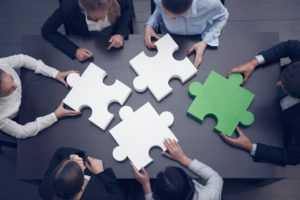Table of Contents
For businesses, deciding between Co-Managed IT vs. Managed IT Services is about determining which services you truly need from your Managed IT Service Provider (MSP). At IntegriCom, we help business owners understand and decide which type of managed IT services arrangement will work best. Every business is unique, so a cookie-cutter all-in-one Managed IT solution is not always the best option.
In this article, we will look at the pros and cons of Co-Managed IT vs. Managed IT Services and help you understand the options when choosing the right service for your business.
What is Co-managed IT vs Managed IT?
Managed IT Services Definition
Managed IT services is when the managed services provider fully takes care of the business’s technology. The outsourced managed IT services firm is the IT department.
They can function as a part of the business’s team. If fact it works best if they are completely part of the business’s team, where they are part of the leadership meetings, planning meetings, etc. That way they can provide technology guidance and input when needed, and early enough in the process to be effective.
 Co-Managed IT Definition
Co-Managed IT Definition
Co-managed IT is where a business has an IT Department, but it is supplemented from the outside – from a managed IT services firm.
Sometimes a business has someone, or more than one person internally that performs some of the IT department roles, but they are not able to perform all of them.
It may be because they do not have the time, or perhaps they do not have the skills. A business like this can enter into a co-managed IT support arrangement with a managed IT services provider. In this scenario, the managed IT service company’s role is to support the internal staff and make them better and make the IT department better.
Co-managed IT support is where the managed IT services firm fills roles that are not filled internally, they support the internal staff to get all work complete and be able to provide full metrics to management.
In some cases, the managed IT services firm may support all the network and security work while the internal staff handles all the computer systems and user support. In other businesses, the managed IT services firm may simply provide help desk user support while all other tasks are addressed internally including business phone systems and
small business cloud services. It can be any combination of tasks distributed in ways that make sense for the business.
Co-managed IT can be any combination of tasks distributed in ways that make sense for the business.
What they have in common…
For both Managed IT Services and Co-managed IT Services, base line services are provided such as:
- Security Software & Solutions
- Software Patching
- Data Backups
- Remote Access
Typically, frequent reporting and periodic IT review meetings are provided in both scenarios too. And in both cases, the MSP is a trusted advisor.
How they are different…
Managed IT Services include all IT services, and the client gets the results of those services. But co-managed IT services provides only the services that the client’s needs, but with some unique things added.
A co-managed client gets access to the technology tools, dashboards, ticketing system, and documentation system. They also get an IT mentor. These things allow them to perform their duties as a higher level and much more efficiently.
Managed IT vs. Co-Managed IT Services
Managed IT | Co-Managed IT | |
IT Department | IS the IT Department | Complements the IT Department |
IT Staffing | Is the staff | Supplements the staff |
IT Strategy | Business can pursue strategic initiatives without IT distractions and worry. | Provides non-threatening, non-competitive enhancements and efficiencies to internal IT |
IT Tools | Utilized by MSP only | Shared with internal IT |
Training/Mentoring | Business does not invest in IT learning | Training & mentoring to internal IT |
Vacation / Sick Leave | MSP has many employees, and a qualified person is always available | Can cover for internal IT staff when they are away |
What are the pros and cons of choosing Co-managed IT?
For businesses who want to maintain internal control over their technology, co-managed IT can be a better fit. Co-managed IT services support businesses in their IT strategy, providing extra resources for over-stretched IT departments, an escalation point, mentoring, etc., but the MSP does not fully own or have full control over the technology.
 With co-managed, a business has more flexibility but there can also be less structure and controls if internal staff not disciplined. The business maintains control and internal staff. This also makes the services from the MSP cheaper, but it does not replace the internal costs. Subscribers to co-managed IT do have external expertise to call on when needed, and there is a built-in training/mentoring for the internal staff.
With co-managed, a business has more flexibility but there can also be less structure and controls if internal staff not disciplined. The business maintains control and internal staff. This also makes the services from the MSP cheaper, but it does not replace the internal costs. Subscribers to co-managed IT do have external expertise to call on when needed, and there is a built-in training/mentoring for the internal staff.
Pros of Co-managed IT | Cons of Co-managed IT |
Business has more control | Business has more responsibility |
More flexibility | There can be less structure & controls |
Business keeps internal IT staff | Business keeps overhead of internal IT staff |
Keep some expertise in-house | Shared responsibility for expertise |
Costs less than fully managed IT | Higher internal IT costs |
Have highly qualified external expertise to call on | |
Have qualified on-going mentorship/training process in place |
What are the pros and cons of choosing Fully Managed IT?
For business who want to fully outsource their IT to a qualified team, full managed IT Services is the best solution. There are less worries and responsibilities as the managed IT provider takes care of it all, but then there is less control for the business.
The network and infrastructure are always maintained, updated, and kept current. And there is no need to maintain IT expertise, but then there is also no one to call on within the office and a service ticket must be submitted with the managed IT company (thus, it’s important to have one that is very responsive).
A managed IT firm also has more technical resources with higher levels of expertise that a business would typically have on their own. While using a managed IT firm increases the outsourced/external costs, there are no internal IT costs.
Pros of Fully Managed IT | Cons of Fully Managed IT |
Less worries and responsibilities | Less control |
No need to maintain IT expertise | No in-house expertise |
More & higher expertise to call on | No at-hand expertise to call on |
No internal costs | Higher external/outsource costs |
Network and infrastructure always up to date |
How To Select The Right IT Service Model
When determining which model is best for you, there are several things to consider around your existing staff, your IT needs, your desired level of control, and your desired level of responsibility.
Who Should Consider a Fully-Managed Solution?
Do you have internal IT staff?
If not, the fully managed model may be the best fit for you. It is expensive to hire qualified IT professionals, and there is no way to get all the needed expertise in one or two people. It is always best to hire a team that is qualified in all areas needed and across many people. Plus, you never have to worry about sick leave and vacation, as the MSP will always have someone available for you.
The IT MSP will take care of all things IT, provide monthly reports so you can know what they are doing, and provide quarterly or periodic meetings to dive into more details. This gives you what you need in an IT department without having to build and maintain it.
 Who Should Consider a Co-Managed Solution?
Who Should Consider a Co-Managed Solution?
If you do have IT staff, then perhaps the co-managed model is good for you.
Do you know all that is needed to maintain your network and technology infrastructure, and to keep you safe? Is your current staff qualified to do all that is needed?
Most likely not, so hire an IT MSP in a co-managed arrangement to fill the gaps, plus help raise the level of expertise of your existing staff. And give your existing staff the IT tools to do their job better and more efficiently. This provides a much more manageable way to build and maintain your IT department, and you always have the IT MSP to call on when internal resources are away or need help.
Summary
Both Co-Managed IT and Fully Managed IT play vital roles in small and medium sized businesses today. Some businesses need one model and other businesses need the other model. Contact us to know what the right fit is for your business.
Co-Managed IT vs. Managed IT…What is the right fit for you?
Please contact us at IntegriCom if you have any questions or need help in either model. We love to help!




